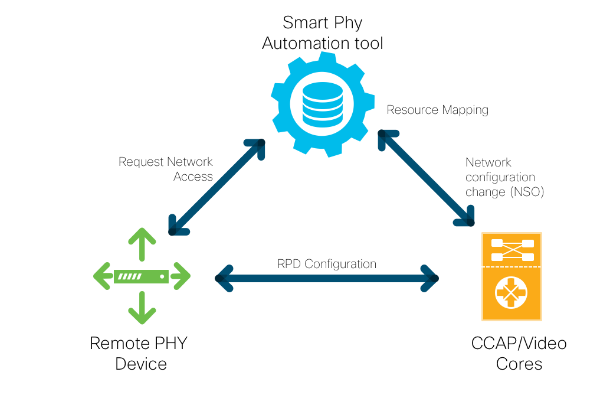
A couple weeks ago, we announced the availability of the RPHY Compact Shelf, complementing our Infinite Broadband solution launched in May 2017 at ANGA.COM. With the RPHY Compact Shelf extending support for Remote PHY to hub site deployments, the Infinite Broadband solution now includes everything you need to make Remote PHY a reality:
- A CMTS core capability with the Cisco cBR8
- Two types of Remote PHY Devices (RPDs), the GS7000 RPHY Node for Deep Fiber deployments and the RPHY Compact Shelf.
One of the main benefits of migrating to a Remote PHY deployment is the reduction in Total Cost of Ownership (TCO). However, deploying a massive number of RPDs and manually configuring and provisioning them would not afford you any operational savings.
Here’s where automation comes into the picture, today Cisco is introducing Smart PHY, a vendor-agnostic Remote PHY automation tool that enables full automation of the provisioning, configuration and maintenance of the RPDs and RPHY cores.
How would it work? A typical Remote PHY deployment could include anywhere from two hundred-and-fifty RPHY RPDs up to five hundred RPHY RPDs, per CMTS core. If an MSO has one hundred cBR8s, that adds up to fifty thousand RPHY RPDs to configure. That’s a ton of work, hence the need for the Smart PHY automation tool.
Let me explain how the manual process and the automated process would compare:
The manual process (how most operators deploy network equipment today)
- Requires manual configuration of both RPD and CMTS/Video Cores
- This is error prone at scale, the process makes it difficult to keep track of resources used, requires per RPD configuration and the field technician needs to know how to configure an RPD (special skill set)
- Manual provisioning requirements
- DHCP server must know the CCAP/Video cores, which leads to inflexible load balancing. Also, in a line card high availability (LCHA) scenario the DHCP server needs to be configured with the protect card to come online during a LCHA event.
- Validation and debugging needs to be done manually
- Monitoring is based on Syslog messages
The automated process (how it would work with Cisco Smart PHY)
The automation process is applied to all RPDs simultaneously (if needed) and includes:
- Automated initial RPD installation and RPD provisioning with zero-touch of the Cisco CMTS or RPD. The field technician does not need any special skills.
- RPD inventory operations. For example, running inventory reports or searching for RPDs based on specific criteria.
- RPD health management.
- RPD software update automation and version management.
So, how do you quantify the value add of automation? We have a pretty good idea as to the processes and costs associated with a typical RPHY deployment, and that allows us to come with the following data points. Obviously, we have to make some assumptions in our ROI model, but the impact is real.
 About Smart PHY
About Smart PHY
The Smart PHY application is based on model-driven network configuration protocol (NETCONF) and YANG technology, and it’s using a micro services architecture. Smart PHY uses Cisco’s Network Services Orchestrator (NSO) technology. Visit here to learn more about NSO.
 To find out more about the Cisco Infinite Broadband solution and Smart PHY, visit our cable access solution page or download a copy of our Road to Cisco Infinite Broadband E-Book today.
To find out more about the Cisco Infinite Broadband solution and Smart PHY, visit our cable access solution page or download a copy of our Road to Cisco Infinite Broadband E-Book today.
by: Daniel Etman


















